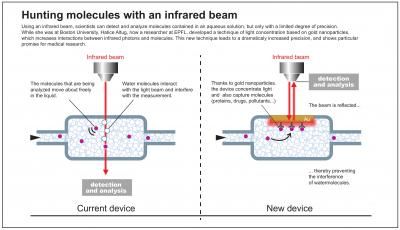Hula-Hoop Nanotechnique
Periodic nanostructures made of gold nanoparticles and long DNA strands with repeated sequences
Multifaceted DNA: in our bodies it carries our genetic information; in the hands of scientists it continues to reveal itself as the material of choice for nanotechnology. DNA is very stable and mechanically strong, and because of the specific base pairing in the double strand predictable structures are accessible. Canadian researchers led by Michael A. Brook and Yingfu Li have now successfully produced specific, periodic three-dimensional nanostructures from long single strands of DNA and gold nanoparticles. The researchers see nanocomputers, nanocircuits, and highly sensitive biosensors as potential areas of application.
The secret to their success is a DNA duplication technique known as "rolling circle amplification" or the "hula-hoop" technique. A ring of single-stranded DNA is used as the model, a special polymerase enzyme "reads" this model and builds the corresponding complementary strand. When this is complete, this type of polymerase, unlike ordinary polymerases, does not stop working. It is able to separate the fresh strand from the original and continues to copy the model again without interruption. This leads to long (theoretically infinitely long) single strands of DNA with a sequence of repeating patterns.
The team attached short DNA fragments to gold nanoparticles with a diameter of 15 nm. Tiny rings of DNA were then hooked on by way of specific base pairs and a hula-hoop-capable form of polymerase was added. That started it off: round and round the loop until long DNA chains hung from the little gold spheres. In order to demonstrate that these aggregates are good scaffolds for 3D structures, the researchers added smaller gold particles (5 nm diameter), each equipped with one short DNA segment. The sequence of these fragments was complementary to one region of the repeated sequence of the long DNA chains, so the fragments docked onto the larger structure. Because the pattern periodically repeats, the long DNA strands were now equipped with many little gold particles at regular intervals-like pearls on a necklace. The result is a periodic nanostructure.
"The construction and microstructure of such three-dimensional nano-entities can easily be controlled. Because DNA base pairing can also be broken up, these structures can be reversibly put together and taken apart again." Brook and Li consider this to be one of the special advantages of their "nanoconstruction kit".
Original publication: Y. Li; "DNA Polymerization on Gold Nanoparticles through Rolling Circle Amplification: Towards Novel Scaffolds for Three-Dimensional Periodic Nanoassemblies"; Angewandte Chemie International Edition 2006, 45, 2409.
Most read news
Topics
Organizations
Other news from the department science
These products might interest you

Octet R2 / Octet R4 / Octet R8 by Sartorius
Full power on 2, 4 or 8 channels: Label-free and GxP-compliant analysis of molecular interactions
Innovative label-free real-time protein quantification, binding kinetics and rapid screenings

Octet SF3 by Sartorius
Surface Plasmon Resonance (SPR) using Single Dynamic Injections for Kinetics and Affinities
Curvature is Key - Adding a ‘Third Dimension’ to the Binding Curve

Octet RH16 and RH96 by Sartorius
Efficient protein analysis for process optimisation and manufacturing control in high-throughput
Label-free protein quantification and characterization of protein-protein interactions

Get the life science industry in your inbox
By submitting this form you agree that LUMITOS AG will send you the newsletter(s) selected above by email. Your data will not be passed on to third parties. Your data will be stored and processed in accordance with our data protection regulations. LUMITOS may contact you by email for the purpose of advertising or market and opinion surveys. You can revoke your consent at any time without giving reasons to LUMITOS AG, Ernst-Augustin-Str. 2, 12489 Berlin, Germany or by e-mail at revoke@lumitos.com with effect for the future. In addition, each email contains a link to unsubscribe from the corresponding newsletter.





















































